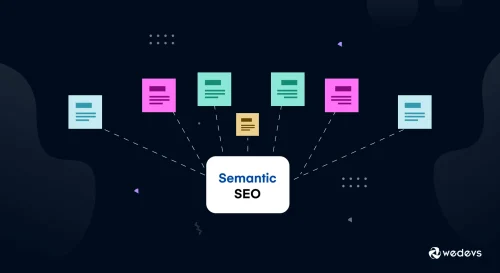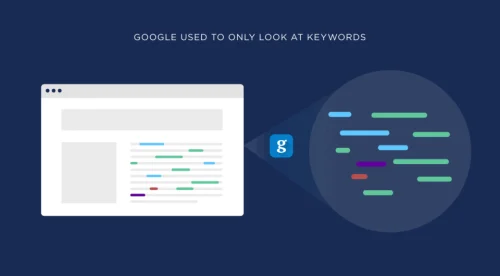Semantic SEO involves optimizing content to anticipate and satisfy user intent by focusing on meaning and context. To optimize for higher rankings, integrate related concepts, synonyms, and natural language into your content.
Semantic SEO transforms the traditional method of keyword-focused optimization into a holistic content strategy, comprehensively addressing user queries. It leverages the nuances of language, context, and intent behind search terms. Crafting content with semantic SEO in mind ensures that a website not only contains keywords but also provides relevant, valuable information that search engines can understand and users can appreciate.
This approach aligns closely with the sophisticated algorithms of search engines like Google, which aim to serve the most accurate and informative content to users. As search technology advances towards better understanding human language, semantic SEO becomes a cornerstone for professional SEO experts. By grasping the full scope of topics and subtopics within your content, you can enhance your website’s visibility and relevance, leading to improved search engine rankings.

The Basics Of Semantic SEO
Definition Of Semantic SEO
Semantic SEO is the practice of building more meaning and relevancy into web content. It focuses on topics rather than just keywords. This approach helps Google match high-quality content with a wide range of searches. Rank for more keywords by applying the best SEO techniques focused on semantics.Benefits Of Semantic SEO
Opportunities for internal linking increase with Semantic SEO. This builds a network of valuable content, improving domain authority. Relevant, in-depth content ensures that visitors spend more time on the site. Increased average time signals to Google that you provide helpful content.- Meet Google’s EAT guidelines
- Expand your reach with broader topic coverage
- Create user perspective-centric, high-quality content
| Strategy Component | How It Supports Semantic SEO |
|---|---|
| Comprehensive Keyword Research | It reveals related topics and searcher intent. |
| In-depth Content | It satisfies multiple related queries in one go. |
| Structured Data | It helps Google understand the content’s context. |
Key Elements Of Semantic SEO
Entity-based Optimization
Entity-based optimization is the backbone of semantic SEO. This strategy ensures that content focuses on things, not strings. ‘Things’ refer to entities, or concepts and objects that are distinct and well-defined. Focusing on entities aligns your content with the way modern search engines think. Here’s how you can achieve it:- Identify and satisfy search intent: Understand your audience’s needs and provide answers.
- Explore topics, not keywords: Consider broader subjects and related concepts.
- Build your site like Wikipedia: Create rich, interconnected content that stands as an authority resource.
Structured Data Markup
Structured Data Markup helps search engines understand and display content effectively. It organizes information so search engines can easily parse it. Here are some tips:- Use structured data to help Google understand the content on your pages.
- Use semantic HTML to improve context understanding.
- Listen to Google SERPs as they often hint at what structured data might be beneficial.

Optimizing Content For Semantic SEO
Creating High-quality Content
A solid foundation of stellar content is crucial. It should directly answer users’ questions and address their pain points with clarity and authority.- Stay on topic, ensuring every paragraph adds value to the main subject.
- Offer unique insights that distinguish your content from others.
- Make use of subheadings, bullet points, and tables to break up text and make information digestible.
Using Semantic Keywords
Keywords are now about context. Choose terms that reflect the subject in-depth.- Identify primary keywords relevant to your topic.
- Research related terms and phrases that provide contextual meaning.
- Incorporate LSI keywords (Latent Semantic Indexing) to cover related concepts and synonyms.
| Primary Keyword | Related Terms | LSI Keywords |
| Healthy Eating | Nutritious Food Choices, Balanced Diet | Clean Eating, Dietary Fiber, Vitamins and Minerals |
Technical Optimization For Semantic SEO
Mobile Optimization
Mobile optimization is crucial for semantic SEO. Search engines prefer sites that work well on mobile devices. Use these strategies to optimize for mobile:- Responsive Design: Ensure your site automatically adjusts to fit any screen size.
- Readable Fonts: Choose fonts that are easy to read on small screens.
- Accessible Menus: Menus should be simple to navigate on a touch screen.
- Touch-Friendly Buttons: Make buttons large enough for finger tapping.
Page Speed Improvement
Speed is a top factor for semantic SEO. A fast-loading page keeps visitors happy. Follow these steps to improve page speed:- Compress Images: Use tools to reduce image size without losing quality.
- Minify Code: Remove unnecessary characters from HTML, CSS, and JavaScript.
- Use Caching: Store parts of your site locally to speed up loading times.
- Choose Fast Hosting: Pick a reliable hosting service that offers quick server response times.

The Role Of User Experience In Semantic SEO
Optimizing For User Intent
Understanding and fulfilling user intent is a cornerstone of Semantic SEO. It begins by identifying the types of queries visitors are likely to use. These insights guide content creation, ensuring alignment with what users seek. Consider these steps:- Research common questions and keywords in your niche.
- Create content that directly addresses these queries.
- Use clear and descriptive headings and subheadings.
- Ensure content depth covers all aspects of the topic.
Improving Website Navigation
Website navigation has a strong impact on how visitors interact with your site. Key factors include:- Ease of finding information: Menus, search bars, and clear paths to content are essential.
- Logical flow: Site structure should make sense to first-time visitors.
- Mobile responsiveness: Access to content on all devices is a must.
Utilizing Featured Snippets And Rich Results
Understanding Featured Snippets
Google Search aims to deliver fast, accurate answers. Featured snippets, also called “position zero,” achieve this by highlighting a piece of content that directly answers a user’s question. They stand out at the top of google search results, capturing user interest. To optimize for featured snippets:- Identify common questions related to your content.
- Provide clear, concise answers in your text.
- Structure your content with lists, and tables where appropriate.
- Keep sentences short and informative.
Maximizing Rich Results
Rich results go beyond basic blue links on a search engine result page. They include extra visual or interactive features. Rich results can be reviews, recipes, or events with specific details, such as ratings or dates, displayed directly on SERPs. To enhance rich results, consider these tips:- Use schema markup to provide context to search engines.
- Make sure your website is mobile-friendly.
- Include high-quality images and videos when relevant.
- Test your markup with Google’s Rich Results Test tool.
| Element | Featured Snippets | Rich Results |
|---|---|---|
| Content Quality | Direct answers to questions | Engaging, media-rich content |
| Structure | Use of headers and lists | Schema markup for context |
| Visibility | Top of google search results | Detailed information shown on SERPs |
Measuring Success With Semantic SEO
Key Performance Indicators (KIPs)
Effective analysis starts with setting clear objectives. Every website should define KPIs reflecting its goals. Here are some KPIs to consider:- Organic Traffic: Number of visitors coming from search engines.
- Keyword Rankings: Visibility for relevant semantic queries.
- Click-Through Rate (CTR): Ratio of users who click on a link to total users who view it.
- Bounce Rate: Percentage of visitors who leave after viewing one page.
- Conversion Rate: Percentage of visitors who perform a desired action.
Tools For Monitoring Semantic SEO
Diverse tools are available to track these KPIs:- Google Analytics: Track user behavior and traffic sources.
- Google Search Console: Analyze search queries and your site’s performance.
- Ahrefs: Study keyword rankings and domain strength.
- SEMRush: Monitor keyword strategies of competitors.
- Moz Pro: Assess page optimization and keyword opportunities.
Trends And Future Of Semantic SEO
Voice Search Optimization
Voice search grows rapidly. Google values natural language queries. Content should answer questions directly. Simple language works best. Optimize for user intent and user experience.- Create content that sounds conversational
- Anticipate questions and provide clear answers
- Use structured data for better context
- Include local SEO strategies for location-based queries
- Optimize content for featured snippets
Machine Learning Impact
Google’s EAT (Expertise, Authoritativeness, Trustworthiness) model thrives on AI. NLP (Natural Language Processing) and machine learning impact SEO. They enhance contextual understanding.- Develop content quality with machine learning insights
- Adapt content to meet semantic search changes
- Apply LSI (Latent Semantic Indexing) for related terms
- Use AI tools for content optimization
- Monitor performance and refine strategy accordingly
| Strategy | Benefits |
|---|---|
| Rank for more keywords | Increased average time on site, improved domain authority |
| Opportunities for internal linking | Improved content quality, better user engagement |
| Explore topics, not keywords | Identify and satisfy search intent, build in-depth content |
| Use semantic HTML | Contextual understanding for search engines, better content access for all users |
| Build your site like Wikipedia | Links to relevant articles provide value, encourage extended user visits |
Frequently Asked Questions For What Is Semantic SEO And How To Optimize For Higher Ranking
How Do I Optimize My Content For Semantic Seo?
To optimize content for semantic SEO, focus on topical relevance, use related keywords naturally, include synonyms and variations, structure content with header tags, and provide in-depth, quality information that answers user queries comprehensively.
What Is Semantic Seo?
Semantic SEO involves optimizing content by focusing on meaning and context to improve search engine understanding and user relevance, beyond just targeting specific keywords.
How Can I Improve My SEO Ranking?
To boost your SEO ranking, ensure your website is mobile-friendly, optimize for relevant keywords, and regularly publish high-quality, original content. Acquire credible backlinks and improve site speed for better user experience. Keep your meta tags and descriptions clear and concise.
What Is Seo And How Do You Optimize It?
SEO stands for Search Engine Optimization, which improves a website’s visibility in search engine results. To optimize SEO, integrate relevant keywords, create high-quality content, ensure mobile-friendliness, improve page loading speed, and acquire authoritative backlinks.
What Is Semantic Seo?
Semantic SEO refers to optimizing content by focusing on user intent and the contextual meaning behind search queries rather than just including target keywords.
Why Is Semantic Seo Important?
Semantic SEO is crucial as it helps search engines understand the context of content, improving relevance and chances for higher rankings on search engine results pages (SERPs).
How Does Semantic Seo Affect Rankings?
Semantic SEO improves rankings by aligning content more closely with user intent and providing comprehensive answers to queries, which is favored by search engine algorithms.
Can Semantic Seo Improve User Experience?
Yes, Semantic SEO enhances user experience by delivering content that directly answers the searcher’s questions and provides in-depth information.
What’s The Role Of Structured Data In Semantic Seo?
Structured data communicates to search engines what your content means, enabling rich snippets and improved SERP visibility, which are key components of Semantic SEO.
How To Optimize Content Using Semantic Seo?
Optimize content with Semantic SEO by researching related keywords, using synonyms, covering subsidiary topics, and ensuring it aligns with user intent.
Conclusion
Embracing semantic SEO is crucial for digital success. It’s about context, not just keywords. This approach requires understanding user intent and crafting valuable, relevant content. By optimizing for themes, not just specific phrases, you enhance visibility and drive organic traffic.
Start optimizing semantically now to outshine competitors and escalate rankings.


Pingback: What is Topical Authority in SEO? A1 Technovation
Pingback: How Do I Create a SEO Topical Map for My Website? | A1 Tech
Pingback: On-Page SEO | The Complete Guide for 2024 | A1 Technovation